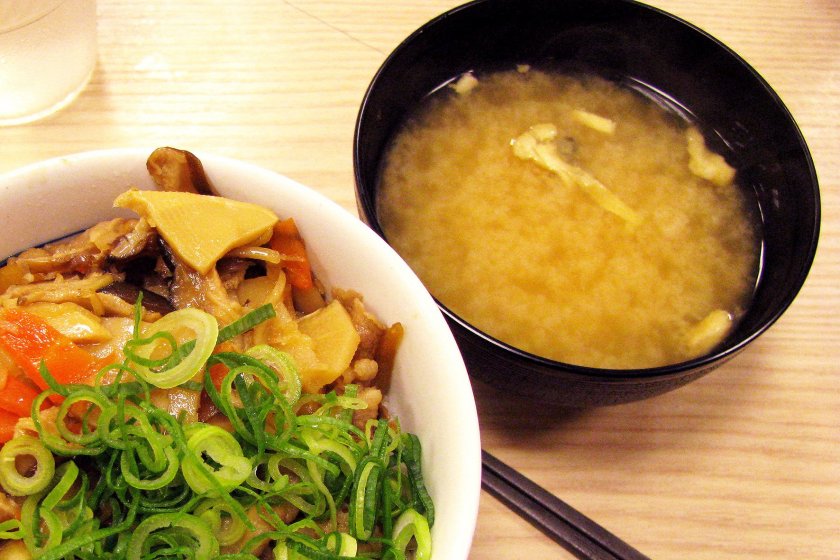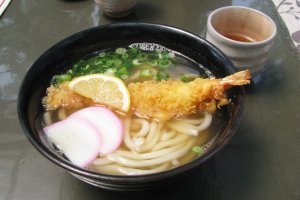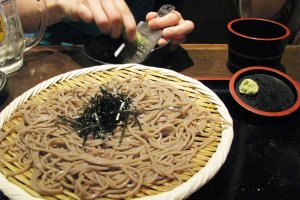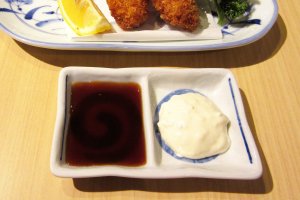Many ingredients used in Japanese cuisine have become popular all over the world, but not everyone knows what they are or how they are produced.
Miso
Miso is a fermented paste and the basis of miso soup. It's made from soybeans, salt and koji rice starter which provides fermentation using the mold Aspergillus oryzae grown on rice grains. Crushed soybeans are mixed with boiled rice (or other cereals), with salt and sourdough added. The mixture is intensively whipped and left to ferment for at least six months. A shorter period leaves the paste lighter and sweeter. Depending on the region, miso paste recipes vary with ingredients like tofu, mushrooms, nori, green onions and seafood.
Udon and Soba

Udon and soba are noodles; udon made from wheat flour and soba from buckwheat flour. The noodle dough features the addition of salt and is then rolled out, cut with a special knife into narrow strips, then dried. The noodles are then boiled and used in a huge variety of dishes and can be served both hot or cold, in broth, with different ingredients like meat, egg, vegetables, herbs, mushrooms, and shrimp.
Nori
Nori is a seaweed, of an edible species of red algae known as Pyropia. Nori are prepared in a way similar to making paper, it's well washed, then crushed, pressed and then dried. After drying, the red algae acquires a dark green color, and the texture resembles thin translucent paper. Nori are used for making sushi, wrapping onigiri. Thinly sliced, they are used as a seasoning for many dishes.
Soy Sauce

Soy sauce is a popular seasoning. It contains four main ingredients: soybeans, wheat, salt, and fermenting agents such as Aspergillus mold fungus, or yeast. The process begins with soaking soy, roasting and grinding wheat. The prepared products are mixed with mold after which they are left to ferment for several days. Water and salt are added and the resulting thick mixture is placed in barrels and left for 4-6 months. Special varieties of sauce can stay in barrels even longer. Afterwards, the mixture is squeezed out with the liquid part pasteurized to stop the fermentation process. Then the sauce is bottled.
Wasabi

Real wasabi is a well-known green seasoning made from the root of a plant with the same name. Wasabi requires special growing conditions - a complex combination of soil and running water with a temperature between 10-17°C throughout the year. Underground hot springs help to maintain the temperature and such water is found in mountain rivers in prefectures like Nagano and Shizuoka. To get wasabi paste, no additional ingredients are used, and the manufacturing process is simple - the ripe roots are harvested, cleaned and rubbed to a paste state.
Curry

In Japan, the term 'curry' means a slightly sweet - certainly not spic - gravy with pieces of vegetables and meat. Curry is served in one plate with boiled rice and mixed gradually during meals. Curry recipes are very diverse, but all contain curry seasoning. Curry contains traditional ingredients like ground turmeric, coriander, cumin and black pepper. To make curry, the seasonings are mixed and fried in a hot frying pan for a minute, then cooled and ground to a homogeneous mass.
Tofu

Tofu is a soy bean product rich in protein, iron and calcium. It's obtained by fermenting soy milk protein when heated or filtered. After folding, tofu is often pressed and the final product is usually white or off-white in color. In general, the production of tofu resembles the process of obtaining cottage cheese from milk, which is why tofu is often called 'soy curd'. Since tofu has little to no taste, it is consumed with products that have a pronounced taste. Tofu is fried, baked, used in fillings, soups, sauces and desserts.
Katsuoboshi

Flakes of dried, smoked and fermented tuna, katsuboshi is the main ingredient for dashi stock and is also used as a condiment for hot dishes like takoyaki and okonomiyaki. Making it, though, is quite laborious. Caught far out in the ocean with rods, the fish is immediately frozen. On shore, without defrosting, fillets are then cut, smoked over oak firewood and dried in the sun, acquiring an almost stone-like hardness. Next, the hardened fillet is put into wooden boxes and treated with Aspergillus before being cut into thin transparent flakes using a plane-like tool.
Tempura

In Japan, this term refers to a variety of products fried in batter. The batter is made from fine flour, egg yolk and cold water. Pure sesame oil is used to prepare tempura with ingredients like vegetables and prawns dipped in the batter and then fried in oil heated to 170-180°C.
Mochi

A type of rice dough, mochi is made from the sticky rice mochigome. The rice is soaked overnight, boiled or steamed and then pounded with a wooden mallet in a large mortar. The process requires two people - one pounds the dough while in between mallet strikes, the other keeps the dough moist. The result is a stretchy, sticky dough, slightly sweet in taste. Very popular, various desserts are made from mochi, and it's even used in soups and other dishes.
Matcha tea

Matcha is a high-quality powdered green tea made from the upper leaves. Grounded with a stone millstone, this powder is used in the Japanese tea ceremony and is one of the most popular additives to dishes and desserts.




































